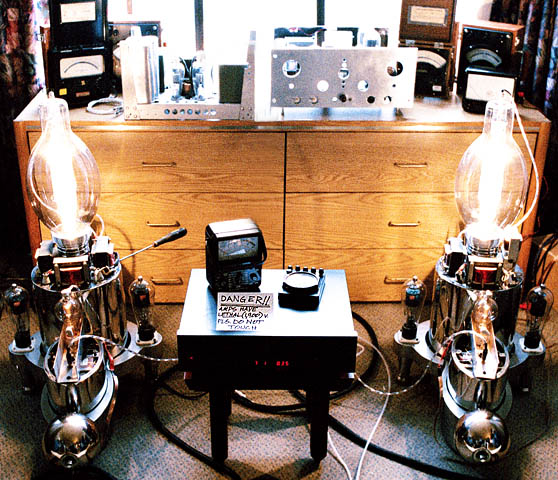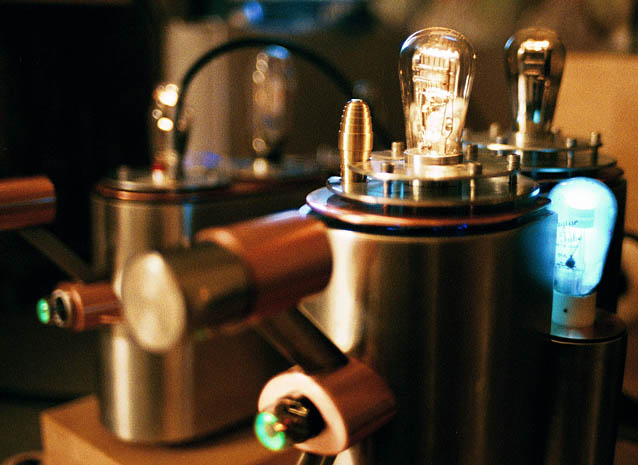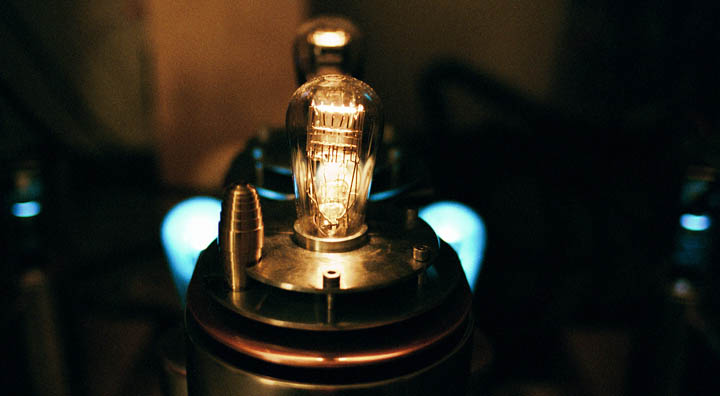
Only at the VSAC - 1900 volts, dazzling filaments, and the engine-room smell of ozone.
Vacuum Tube Valley VSAC 2003 Show Report

Now that the kiddies have gone to bed, I can show you the real VSAC, real-life scenes you'll never see at any CES or Stereophile show. Yes folks, that's 1900 volts behind the yellow crime-scene tape, so no kids, cats or Stereophile reviewers allowed here. The only thing missing is a Jacobs Ladder - zaaaap - snap - zaaaap - snap - and the Bride of Frankenstein.
As you can imagine, when Josh got these monsters up and running, word spread through the Friday crowd like wildfire. "Have you seen what Josh did this time?" "The GM100's are unbelievable!" Many show-goers were speechless when they saw them light up - I certainly was. To give sense of scale, the GM100 transmitter tubes are two-and-half feet high, and about 8 inches around. Did I mention they were bright?
Word from the floor was both the GM100 amps and Gary Dahl's Aurora's (which have Josh's copper top plates) sounded excellent with the new Electronluv horns, with the Aurora filling in while Josh and his father worked out ways to power up the GM100 amps without immediately taking out the hotel-room circuit breaker. The eventual solution was to power each amp from its own room - yes, this amp was powered by the room next door. Speaking of which ...

Here's the Cain & Cain room, right next door, featuring horn-loaded Fostex Sigma full-range drivers (the Studio BEN-ES) and more Electronluv confections. I couldn't resist taking mood photos - both the Cain & Cain speakers and Electronluv electronics are beautiful sculptures, almost architectural in scale and presence. Josh Stippich and Terry Cain are taking artisan audio away from the mundane world of little boxes made on an assembly line and creating art objects, as singular, beautiful, and purposeful as a grand piano.

The Electronluv circuits are straightforward choke-loaded SE, but Josh builds them with exotic, and fairly rare, direct-heated transmitter tubes and mercury-vapor rectifiers. Josh was one of the first Americans to use DHT power tubes as drivers, inspired by the Sakuma style we saw at the first VSAC show in 1997, but these are not Sakuma amplifiers. He's gone off in his own direction, using bigger and bigger transmitter triodes.
High-voltage DHTs have uniquely linear characteristics (due to large internal spacing of filament, grid, and plate structure). Although B+ voltages above 480V are intimidating for many designers (no electrolytics, special layout considerations, special high-voltage standoffs, etc.), there is a sonic reward in terms of a very powerful, very dynamic power supply.
Looking at audio design from a completely different perspective is a wonderful change from the ever-cautious high-end mainstream, which rarely strays from generic EL34 and KT88-alikes. That's what the mainstream high-end folks have been doing for forty years now, and you know what, the joke is getting a little old.
Wake up, tube designers! If your products haven't been blessed and anointed by the Big Two review magazines, most dealers won't give you the time of day. So playing it safe with the tried and true tube lineup of EL84, EL34, and KT88 won't make any difference. Take a chance! Build something you want!
As you may have guessed, the VSAC is not a marketer-driven show. Unlike the CES, it really does represent the outer limits of audio, and has done that since the first show in 1997.
Page Three
All Text and Photographs © 2003 Lynn Olson.